How To Make A Raised Vegetable Garden Bed
Even if you don't have a lot of time for gardening, you can still have a productive vegetable garden, no matter the size. How? Start with a raised bed. It's the shortcut to a plentiful harvest, even in the first year. Here's why:
Garden anywhere. Attractive cedar raised beds are an asset to your landscape. Create perimeter gardens, spice up your entryway, grow food in your front yard, screen an eyesore.
More food in less space. You can set plants closer together so every square inch is productive. And small-space gardening techniques, such as succession planting and vertical supports, ensure that every square inch of space is used.
Plant earlier. Excess water drains better and soil warms up faster in spring compared to in-ground beds. Specialized covers and garden fabric help you get started even earlier.
Better soil. A productive vegetable garden depends on good soil. With a raised bed, you start fresh with the ideal soil blend — even if the soil on your site is poor.
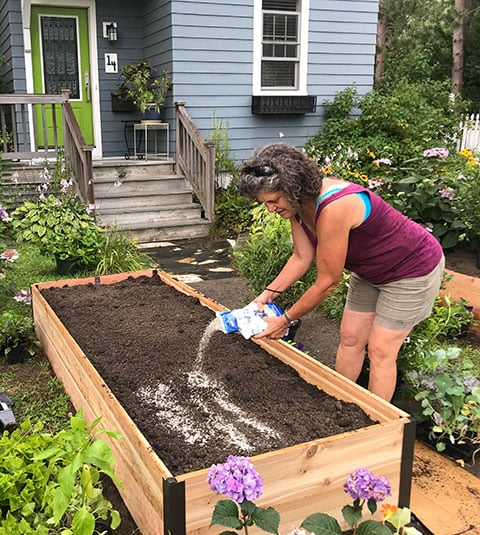 Adding acidifier lowers soil pH for blue hydrangeas, azaleas, and other acid-loving plants.
Adding acidifier lowers soil pH for blue hydrangeas, azaleas, and other acid-loving plants.
Fewer weeds. Because raised beds are densely planted, weeds have little room to grow. And when they do find space, it's easy to pull them from the loose, rich soil.
Easier pest control. It's simpler to manage insects and exclude animal pests compared to long garden rows. You can easily cover beds with row fabrics or specialized covers.
Match soil to plants. Fill the beds with soil customized to plants. For example, do you want to grow blue hydrangeas? Mix a soil acidifier into the soil prior to planting.
Less bending to tend. Deep Root Raised beds are 15" high, so you bend less during planting, caring for, and harvesting plants.
Choosing a Raised Bed
Gardener's Supply offers a wide range of raised beds, from aluminum corner kits for which you supply your own lumber, to complete raised bed kits in cedar, composite wood, recycled plastic and galvanized steel. You can also consider elevated raised beds, for no-bend gardening.
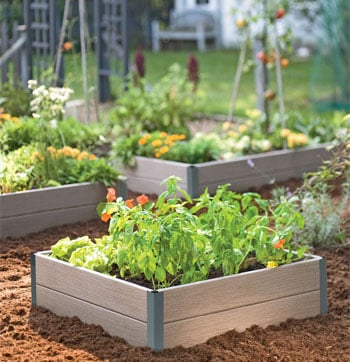 Our Forever Raised Beds can be set up in minutes and last for decades. Made from a composite of recycled wood and plastic, they have the attractive look and feel of silvery aged cedar, but will never splinter or rot.
Our Forever Raised Beds can be set up in minutes and last for decades. Made from a composite of recycled wood and plastic, they have the attractive look and feel of silvery aged cedar, but will never splinter or rot.
Raised beds range in height, starting at about 6". In general, the more soil depth that's available to your plants, the more freely their roots will grow. More soil also holds more moisture, so a deeper raised bed will require less frequent watering.
It is possible to install a raised bed on poor or compacted soil, or even on concrete. If this is the situation you have, buy the deepest bed you can afford. A depth of 10-12" is preferable. Keep in mind that the deeper the bed, the more soil you'll need to fill it. Use the Soil Calculator to determine how much soil you'll need.
How many raised beds should you have? If your space or time is limited, you might want to start out with just one. If you're trying to produce lots of your own fresh vegetables, you will probably need at least three or four beds. Use the Kitchen Garden Planner, our free online garden design tool, to select and place the crops you want to have in each bed. This will help you determine how many total beds you'll need to accommodate everything you want to grow.
Location and Set-up
For optimum plant health and productivity, most vegetables should receive at least eight hours of full sun each day. The more sun, the better, so it makes sense to locate your garden in the sunniest part of your yard. Avoid low, wet areas where the soil could stay soggy. Because your garden will need to be watered during the growing season, you'll want to have relatively easy access to a hose.
Good soil is the single most important ingredient for a good garden. Raised beds give you an immediate advantage over a regular garden, because when you fill your raised bed, you can fill it with a blend of soil that's superior to the native soil in your yard. Soil that's loose and rich with nutrients and organic matter will allow the roots of your plants to grow freely, and ensure that they have access to the water and nutrients they need to sustain healthy growth.
Before placing your raised beds in their permanent location, be sure to remove grass or perennial weeds from the area. Use a garden fork or shovel to loosen the native soil to a depth of 6-10". This will improve drainage and moisture retention in the raised beds. It also means that even with a 5"-high raised bed, your plants will think they're growing in a bed that's 12-18" deep — plenty of room for carrots, potatoes, full-size tomato plants and most any other vegetable you'd ever want to grow.
If you'll be filling more than one raised bed, you might want to buy your soil in bulk — by the cubic foot or cubic yard. Use the Soil Calculator to figure out the total amount of soil you'll need for each bed. For most situations, we recommend these proportions:
- 60% topsoil
- 30% compost
- 10% Potting soil (a soilless growing mix that contains peat moss, perlite and/or vermiculite)
Keep in mind that proportions are approximate because soil volume varies from source to source. For instance, if the calculator specifies .444 cubic yards of soil for your bed, go ahead and buy a half yard.
If you do not have access to quality topsoil, an acceptable substitute would be a 50-50 blend of soilless growing medium (often called "potting soil") and compost. If you want to add peat moss to the bed, it should not be more than 20 percent of the total mix. Peat moss is naturally acidic and is not a good medium for growing vegetables.
What to Plant
Fill your garden with the types of vegetables you like to eat. If you're big on salads, plant head lettuce, a lettuce cutting mix, cherry tomatoes, cucumbers and carrots. If you love cooking, plant onions and peppers, leeks, potatoes and herbs. Try to include at least one vegetable that's new to you. Discovery is half the fun.
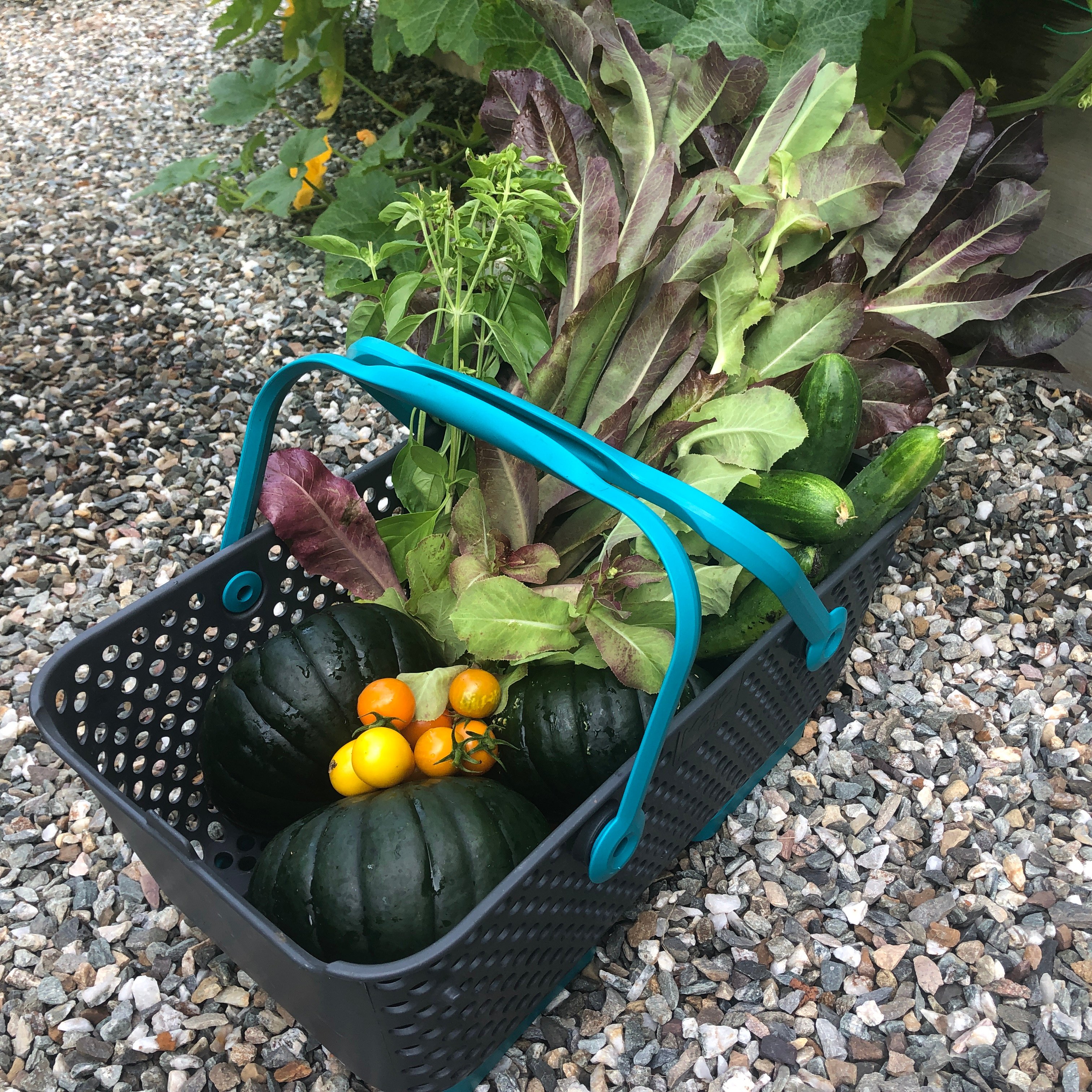 Choose vegetables that you like to eat — or try something that's new to you.
Choose vegetables that you like to eat — or try something that's new to you.
Gardening in a raised bed is all about maximizing productivity. The challenge is to grow as much food as possible while resisting the temptation to squeeze in too many plants. Overcrowded plants never reach their full potential because they're stressed by poor air circulation and competition for water, nutrients and root space.
Our Kitchen Garden Planner provides planting guidelines to help space your plants correctly. Optimum spacing will vary somewhat, depending on specific plant varieties as well as on your growing conditions. A bush watermelon, such as Sugar Baby, has 3 ft. to 4 ft. vines, while the vines of a full-size watermelon, such as Ruby, can be 15 feet long. Likewise, in Texas, tomato plants often get to be over 7 feet tall, yet in Vermont they usually top out at 4 feet. With experience, you'll gradually get a sense for just how much space each type of plant requires.
It's also important consider how each plant's growth habit (bushy, climbing, trailing) will affect its neighbors in same the bed. Planting lettuce next to carrots is fine; planting lettuce next to a sprawling cucumber plant may be a problem. Stakes, ladders and cages will help keep unruly plants from competing with their neighbors. They will also keep the garden neater and more manageable.
Though most of the vegetables you'll want to grow could be started directly in the garden from seed, in many cases it's best to start out with a plant. Starting with a plant usually shortens the time to harvest by a month or more. In cold regions, where the growing season may be less than 100 days, a tomato or pepper plant that's started in the garden from seed will not have time to mature before frost. When you're putting in just one or two plants of a particular type of vegetable (such as broccoli or tomatoes), it sometimes makes more sense to purchase a couple plants rather than invest in an entire packet of seeds.
Vegetables that can be sown directly into the garden from seed include root crops, such as carrots and beets, beans, peas, corn, cucumbers, squash and salad greens. In some cases, these crops are direct-sown because they do not transplant well and it's best to sow the seeds right where they're going to grow. In the case of salad greens, which germinate well and grow quickly, it is simply more economical to purchase a packet of seeds than to purchase multiple six-packs of lettuce seedlings.
Potatoes can be started from seed but almost nobody does so. It's much faster and easier to grow a new potato plant from a tuber rather than from a seed. Onions can be put into the garden as seeds, but more often they go in as plants or as "sets", which are simply tiny mature onions from the prior growing season. For more information, on choosing seeds, seedlings or sets, read Growing Onions. Garlic and shallots are usually planted from sets as well. Leeks go into the garden as young plants. Some herbs should be put in as plants, some (cilantro and dill) should be seeded right where they are to grow.
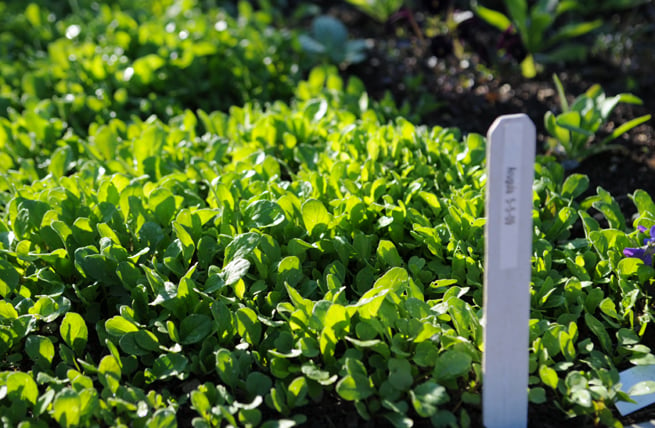 Arugula is a crop that tolerates cool weather.
Arugula is a crop that tolerates cool weather.
When to Plant
There are several factors to consider when deciding when to plant your garden. First is the type of plant you're putting in. Some plants, including lettuce and broccoli, can tolerate cool weather. Others, such as basil and tomatoes, are likely to be damaged or killed by temperatures lower than 40 degrees. Refer to our Vegetable Encyclopedia to determine the best time to plant each crop.
Other important considerations are frost dates and soil temperature. In planting zones 3 to 6, the primary gardening season falls between the first and last frost dates. Cold-sensitive plants must not go into the garden until all danger of frost has passed. This typically falls somewhere between March and May, depending on your growing zone. If you don't know your growing zone, check the USDA zone map.
If you garden in zones 8-10, it may be heat — not frost — that determines your planting dates. Warm-climate gardeners often plant in the fall rather than the spring, to avoid midsummer heat. Others gear up for two planting periods each year: early fall and late winter.
Soil temperature is also an important planting-time consideration. Most plants thrive in a moderate soil temperature of 60 to 70 degrees F. Some, such as peas and spinach, will germinate well and grow just fine in cool (45 degrees F.) soil. Others, such as eggplant and melons, will not germinate, nor will they grow properly unless the soil is above 60 degrees F. The Vegetable Encyclopedia has planting recommendations for each crop.
Some vegetables, including tomatoes, peppers, squash and corn, are typically planted just once each growing season. Other crops, such as salad greens, roots crops, peas and beans, can be planted and harvested early, and then be planted again later in the season for a second harvest. The Vegetable Encyclopedia has crop-specific recommendations for planting (and replanting) to help you maximize production.
Once the seeds have been planted, the area should be watered thoroughly, to a depth of several inches. The soil should be kept consistently moist until the seeds germinate and the young plants have established their first sets of true leaves. Most seeds have a hard coating that must be softened for a period of several days before the seedling inside can emerge. If the soil dries out during this time, the process will be interrupted and you may need to reseed. Covering newly planted areas with garden fabric (or shade netting in the summer) helps keep the top layer of soil consistently moist. This cover can be removed once the seedlings are up and the plants are established.
If possible, young seedlings should be transplanted into the garden when the weather is calm, cool and drizzly. Tender seedlings will suffer if they're planted out on a sunny, hot or windy day. If the weather doesn't cooperate, water your new seedlings thoroughly after planting and then cover them with garden fabric for several days. The plants need time to establish new roots before they are able to extract moisture and nutrients from the soil. If you do not cover them with garden fabric, you may want to find another way to shield them from the sun and drying wind. Be sure to water these new plants every day or two for the first couple weeks.
Tending Your Garden
Planting intensively keeps weeds to a minimum. In the early spring you may need to weed a little every week, but by midsummer your weeding chores should be over. When weeds do crop up, you'll want to remove them quickly so your vegetable plants aren't competing for moisture, nutrients and root space.
The soil in a raised bed doesn't dry out as fast as it does in a regular garden. The sides of the bed help retain moisture and the plants shade the soil to reduce evaporation. Once plants are well-established, your watering chores should be minimal except in hot weather and periods of drought. See the following section on watering for more information.
Crops that grow take three or four months to mature usually benefit from a second, midseason application of fertilizer. Almost all vegetables appreciate a monthly dose of water-soluble fertilizer, especially one that includes humic acid, seaweed and fish emulsion. These water-soluble nutrients are immediately absorbed by plants and help keep them healthy in periods of stress. This is an easy way to minimize pest and disease problems.
You can begin harvesting food from your garden just as soon as it looks ready to eat. Crops are usually tastiest and most nutritious at or just before their peak of ripeness. Remove any spent fruit or foliage, as well as any damaged or diseased plant material. Keep an eye out for pests and address any issues promptly (our Pest and Disease Directory can help you identify potential problems).
Some plants, including pole beans and most tomatoes, need a cage, trellis or another type of support to grow properly and produce a good crop. Plant supports also save space, help keep the garden neat and make it easier to access plants for harvesting.
You will also need to fertilize your plants to keep them healthy and maximize productivity. We recommend using a granular, all-purpose organic fertilizer at planting time and again midseason. You may also want to have some garden fabric (row covers) for transplanting and frost protection, plant ties, and a watering wand or watering can. For more ideas, see all of our products for raised bed gardening.
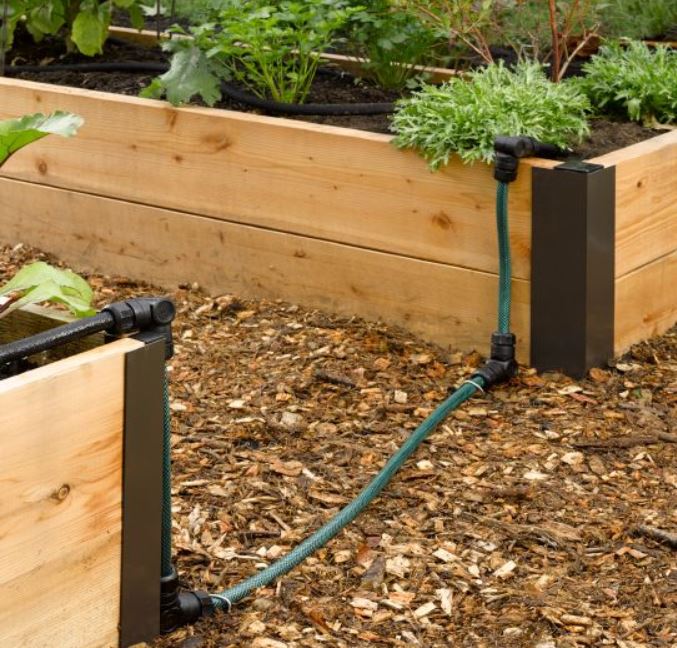 Soaker hoses make watering easy. Use the Snip-n-Drip hoses and connectors to make a watering system that fits any configuration of beds.
Soaker hoses make watering easy. Use the Snip-n-Drip hoses and connectors to make a watering system that fits any configuration of beds.
Watering
In a perfect world, Mother Nature would provide an inch of rain each week to keep our vegetables and flowers perfectly happy. Because that's probably not going to happen, it's up to us to make sure our plants get the water they need to thrive.
A rain gauge will help you keep track of how much rain has fallen, but that's really only part of the story. Different types of soil have different abilities to hold water. A clay-based soil holds onto water because each little particle of clay has lots of surface area for the water to grab onto. Sandy soil, with its bigger particles, lets water pass through quickly. A good loamy soil retains some moisture, yet is also well-drained.
Adding compost to the soil improves its ability to supply your plants with just the right amount of water. Think of sandy soil like a wire basket full of golf balls: turn the hose on and the water runs right through. Adding compost is like adding sponges — water still runs through, but some is stored in the sponges. Compost also helps improve clay soils by aerating them and providing better drainage. Plants absorb oxygen through their roots and can drown if the soil stays soggy for weeks at a time. Raised beds and compost can help prevent this from happening.
The best way to monitor soil moisture is with your hands. When you stick a finger down into the soil, it should feel lightly damp – like a sponge that has been wrung out. Don't just feel the surface; get your fingers down to the root zone (3" deep or so) at least once a week.
In hot weather, plants may wilt during the heat of the day. This isn't always an indication that they're moisture-deprived. In many cases it's simply a way for the plant to reduce moisture loss through its leaves. Checking the soil tells the real story.
Planting intensively in a raised bed garden minimizes moisture loss. Plants shade the soil surface and help protect one another from the wind. Mulching around plants with 2-3" of shredded leaves or straw is another effective way to retain moisture and add organic matter to the soil.
If you determine that your garden does need water, there are several options. A watering wand will deliver quite a bit of water quickly, and get it right where you want it. Too busy to water during the week? Going on vacation in August? Buy a water timer to automatically turn on a sprinkler or soaker hose. Soaker hoses and drip irrigation systems with emitters leak water slowly right at soil level, and are a very efficient way to water.
To keep your plants healthy and productive, don't let the soil dry out completely. If delicate root hairs die back, the plant must direct its energy to re-growing them, rather than to producing fruit. Water-stressed plants can also become bitter and tough.
How To Make A Raised Vegetable Garden Bed
Source: https://www.gardeners.com/how-to/raised-bed-basics/8565.html
Posted by: daviswidefirearm.blogspot.com

0 Response to "How To Make A Raised Vegetable Garden Bed"
Post a Comment